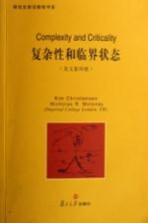
- 作 者:(英)克里斯蒂森,(英)莫洛尼著
- 出 版 社:上海:复旦大学出版社
- 出版年份:2006
- ISBN:7309052021
- 标注页数:392 页
- PDF页数:421 页
请阅读订购服务说明与试读!
订购服务说明
1、本站所有的书默认都是PDF格式,该格式图书只能阅读和打印,不能再次编辑。
2、除分上下册或者多册的情况下,一般PDF页数一定要大于标注页数才建议下单购买。【本资源421 ≥392页】
图书下载及付费说明
1、所有的电子图书为PDF格式,支持电脑、手机、平板等各类电子设备阅读;可以任意拷贝文件到不同的阅读设备里进行阅读。
2、电子图书在提交订单后一般半小时内处理完成,最晚48小时内处理完成。(非工作日购买会延迟)
3、所有的电子图书都是原书直接扫描方式制作而成。
1.Percolation 1
1.1 Introduction 1
1.1.1 Definition of site percolation 3
1.1.2 Quantities of interest 3
1.2 Percolation in d=1 5
1.2.1 Cluster number density 6
1.2.2 Average cluster size 8
1.2.3 Transition to percolation 13
1.2.4 Correlation function 13
1.2.5 Critical occupation probability 14
1.3 Percolation on the Bethe Lattice 15
1.3.1 Definition of the Bethe lattice 15
1.3.2 Critical occupation probability 16
1.3.3 Average cluster size 16
1.3.4 Transition to percolation 19
1.3.5 Cluster number density 22
1.3.6 Correlation function 29
1.4 Percolation in d=2 30
1.4.1 Transition to percolation 31
1.4.2 Average cluster size 33
1.4.3 Cluster number density-exact 35
1.4.4 Cluster number density-numerical 35
1.5 Cluster Number Density-Scaling Ansatz 39
1.5.1 Scaling function and data collapse 41
1.5.2 Scaling function and data collapse in d=1 42
1.5.3 Scaling function and data collapse on the Bethe lattice 44
1.5.4 Scaling function and data collapse in d=2 49
1.6 Scaling Relations 51
1.7 Geometric Properties of Clusters 55
1.7.1 Self-similarity and fractal dimension 55
1.7.2 Mass of a large but finite cluster at p=pc 58
1.7.3 Correlation length 62
1.7.4 Mass of the percolating cluster for p>pc 63
1.8 Finite-Size Scaling 69
1.8.1 Order parameter 70
1.8.2 Average cluster size and higher moments 73
1.8.3 Cluster number density 75
1.9 Non-Universal Critical Occupation Probabilities 78
1.10 Universal Critical Exponents 81
1.11 Real-Space Renormalisation 82
1.11.1 Self-similarity and the correlation length 82
1.11.2 Self-similarity and fixed points 83
1.11.3 Coarse graining and rescaling 85
1.11.4 Real-space renormalisation group procedure 87
1.11.5 Renormalisation in d=1 91
1.11.6 Renormalisation in d=2 on a triangular lattice 95
1.11.7 Renormalisation in d=2 on a square lattice 98
1.11.8 Approximation via the truncation of parameter space 100
1.12 Summary 102
Exercises 104
2.Ising Model 115
2.1 Introduction 115
2.1.1 Definition of the Ising model 116
2.1.2 Review of equilibrium statistical mechanics 119
2.1.3 Thermodynamic limit 123
2.2 System of Non-Interacting Spins 124
2.2.1 Partition function and free energy 125
2.2.2 Magnetisation and susceptibility 127
2.2.3 Energy and specific heat 129
2.3 Quantities of Interest 131
2.3.1 Magnetisation 131
2.3.2 Response functions 133
2.3.3 Correlation length and spin-spin correlation function 134
2.3.4 Critical temperature and external field 135
2.3.5 Symmetry breaking 138
2.4 Ising Model in d=1 140
2.4.1 Partition function 141
2.4.2 Free energy 143
2.4.3 Magnetisation and susceptibility 145
2.4.4 Energy and specific heat 149
2.4.5 Correlation function 151
2.4.6 Critical temperature 154
2.5 Mean-Field Theory of the Ising Model 156
2.5.1 Partition function and free energy 157
2.5.2 Magnetisation and susceptibility 158
2.5.3 Energy and specific heat 166
2.6 Landau Theory of the Ising Model 169
2.6.1 Free energy 170
2.6.2 Magnetisation and susceptibility 172
2.6.3 Specific heat 175
2.7 Landau Theory of Continuous Phase Transitions 175
2.8 Ising Model in d=2 179
2.8.1 Partition function 179
2.8.2 Magnetisation and susceptibility 180
2.8.3 Energy and specific heat 184
2.8.4 Critical temperature 186
2.9 Widom Scaling Ansatz 188
2.9.1 Scaling ansatz for the free energy 190
2.9.2 Scaling ansatz for the specific heat 191
2.9.3 Scaling ansatz for the magnetisation 191
2.9.4 Scaling ansatz for the susceptibility 192
2.9.5 Scaling ansatz for the spin-spin correlation function 192
2.10 Scaling Relations 193
2.11 Widom Scaling Form and Critical Exponents in d=1 195
2.12 Non-Universal Critical Temperatures 198
2.13 Universal Critical Exponents 199
2.14 Ginzburg Criterion 200
2.15 Real-Space Renormalisation 202
2.15.1 Kadanoff's block spin transformation 202
2.15.2 Kadanoff's block spin and the free energy 206
2.15.3 Kadanoff's block spin and the correlation function 209
2.15.4 Renormalisation in d=1 211
2.15.5 Renormalisation in d=2 on a square lattice 215
2.16 Wilson's Renormalisation Group Theory 222
2.16.1 Coupling space and renormalisation group flow 222
2.16.2 Self-similarity and fixed points 227
2.16.3 Basin of attraction of fixed points 229
2.16.4 RG flow in coupling and configurational space 230
2.16.5 Universality and RG flow near fixed point 231
2.16.6 Widom scaling form 235
2.17 Summary 237
Exercises 241
3.Self-Organised Criticality 249
3.1 Introduction 249
3.1.1 Sandpile metaphor 250
3.2 BTW Model in d=1 255
3.2.1 Algorithm of the BTW model in d=1 256
3.2.2 Transient and recurrent configurations 257
3.2.3 Avalanche time series 259
3.2.4 Avalanche-size probability 260
3.3 Mean-Field Theory of the BTW Model 264
3.3.1 Random neighbour BTW model 264
3.3.2 Algorithm of the random neighbour BTW model 264
3.3.3 Steady state and the average avalanche size 265
3.4 Branching Process 267
3.4.1 Branching ratio 267
3.4.2 Avalanche-size probability-exact 268
3.4.3 Avalanche-size probability-scaling form 270
3.5 Avalanche-Size Probability-Scaling Ansatz 273
3.6 Scaling Relations 275
3.7 Moment Analysis of Avalanche-Size Probability 276
3.8 BTW Model in d=2 278
3.8.1 Algorithm of the BTW model in d=2 278
3.8.2 Steady state and the average avalanche size 279
3.8.3 Avalanche time series 280
3.8.4 Avalanche-size probability 281
3.9 Ricepile Experiment and the Oslo Model 285
3.9.1 Ricepile experiment 285
3.9.2 Ricepile avalanche time series 287
3.9.3 Ricepile avalanche-size probability density 289
3.9.4 Ricepile modelling 290
3.9.5 Algorithm of the Oslo model 291
3.9.6 Transient and recurrent configurations 292
3.9.7 Avalanche time series 293
3.9.8 Avalanche-size probability 294
3.10 Earthquakes and the OFC Model 302
3.10.1 Earthquake mechanism 302
3.10.2 Earthquake time series 303
3.10.3 Earthquake-size frequency 304
3.10.4 Earthquake modelling 305
3.10.5 Algorithm of the OFC model 309
3.10.6 Steady state and the average avalanche size 310
3.10.7 Avalanche time series 314
3.10.8 Avalanche-size probability 318
3.11 Rainfall 325
3.11.1 Rainfall mechanism 325
3.11.2 Rainfall time series 326
3.11.3 Rainfall-size number density 329
3.12 Summary 331
Exercises 334
Appendix A Taylor Expansion 341
Appendix B Hyperbolic Functions 343
Appendix C Homogeneous and Scaling Functions 345
Appendix D Fractals 351
Appendix E Data Binning 355
Appendix F Boltzmann Distribution 359
Appendix G Free Energy 361
Appendix H Metropolis Algorithm 363
Bibliography 365
List of Symbols 371
Index 381
